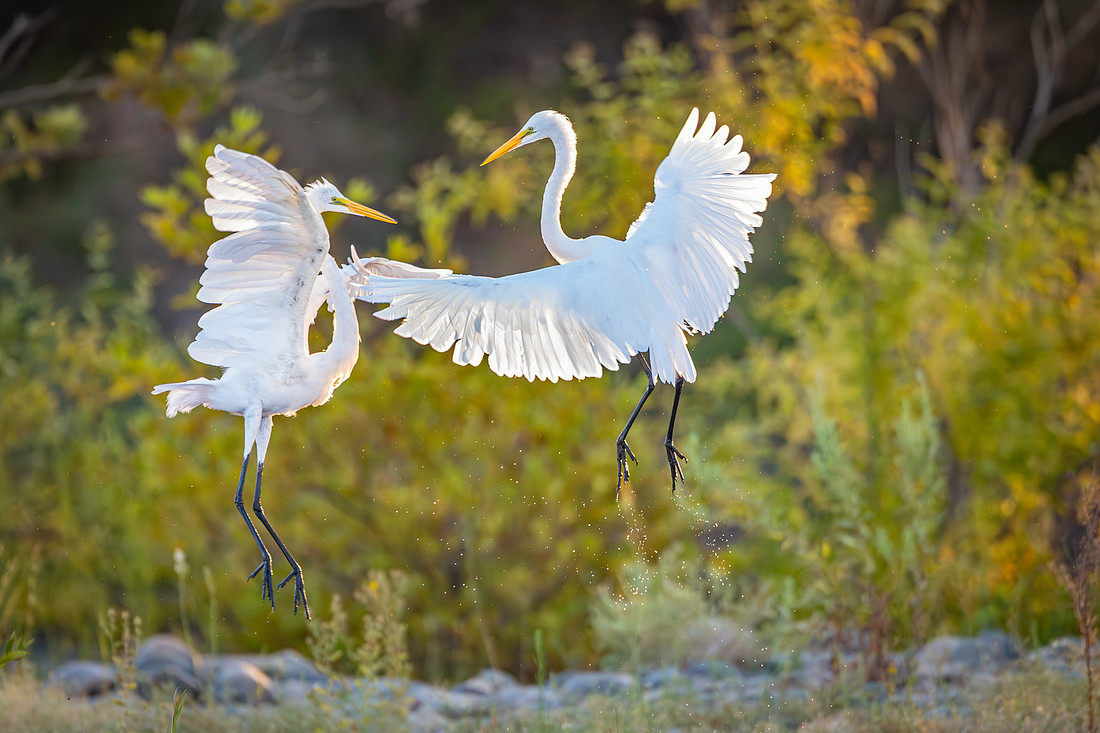Egretfully Yours
Egretfully Yours: A Photographer’s Take on Three Iconic Species
Text and photos by Heather Cline
 
Great Egret hunting at sunset in a coastal lagoon |
Egrets are among the most graceful and photogenic birds found in wetlands, grasslands, and coastal habitats across the globe. With their striking white plumage and elegant movements, they often steal the spotlight in birding checklists and wildlife portfolios. But not all egrets are alike. In this article, we’ll take a closer look at three distinct species—the Cattle Egret, Great Egret, and Snowy Egret.
Whether you're scanning marshes through binoculars or framing a shot in golden light, understanding these birds' behaviors, habitats, and subtle differences can deepen your appreciation and improve your fieldwork. Let’s dive into the lives of these remarkable waders and discover the stories they tell through their size, range, hunting styles, and social lives.
1. Cattle Egret: Known for its symbiotic relationship with grazing animals—an ecological niche that sets it apart from other egrets
Size & Appearance
- Length: 18–22 in with a wingspan of 34–38 in
- Stocky build with short legs and a yellow bill; breeding adults develop orange-buff plumes on head, chest, and back
Range
- Nearly global: Found on every continent except Antarctica
- Originally native to Africa and Asia, now widespread across the Americas, Europe, and Australia
Hunting Behavior
- Opportunistic insectivore: Follows livestock, farm machinery, or wildfires to catch insects and small vertebrates flushed from vegetation
- Prefers dry, open habitats like grasslands and agricultural fields—less dependent on water than other egrets
Social & Mating Behavior
- Breeds in large colonies, often with other wading birds
- Nesting sites are in trees, shrubs, or reed beds near water
- Breeding plumage includes vivid orange bill and legs; courtship involves visual displays and vocalizations
Photo Tips
- Follow the grazers: These birds often forage near livestock or farm machinery. Position yourself where cattle or tractors are active—they’ll stir up insects and draw the egrets in.
- Use a longer lens: A 300mm or longer lens allows you to shoot from a distance without disturbing their behavior, especially in open fields.
- Look for breeding plumage: In spring and summer, their orange-buff plumes pop beautifully against green pastures. Early morning light enhances these tones.
- Capture movement: Cattle Egrets are often in motion—walking, darting, or flying short distances. Use a fast shutter speed (1/1000s or faster) to freeze action.
- Watch for interactions: They can be surprisingly feisty, especially when defending feeding spots. Moments of aggression or alert posture add drama to your shots.
2. Great Egret: Symbol of the National Audubon Society, credited with sparking early bird conservation efforts due to plume hunting in the 19th century
Size & Appearance
- Length: 37–41 in with a wingspan of 51–57 in
- Tall and elegant with all-white plumage, long black legs, and a yellow dagger-like bill
- Breeding season brings long, lacy plumes called aigrettes and neon green facial skin
Range
- Found across North and South America, Europe, Africa, Asia, and Australia
- Common in marshes, swamps, and shallow wetlands
Hunting Behavior
- Classic heron-style stalking: Stands still or wades slowly to spear fish, amphibians, and crustaceans
- Occasionally swims or hovers to catch prey
Social & Mating Behavior
- Breeds in colonies, often the first species to arrive and trigger nesting in others
- Serial monogamy; elaborate courtship displays include plume displays and nest building by males
Photo Tips
- Work the light: Early morning or late afternoon light creates stunning glow-through effects on their plumes. Position yourself with the sun behind you for best results.
- Mind the exposure: Their bright white feathers can easily blow out. Slightly underexpose (-1/3 to -2/3 EV) and check your histogram to preserve detail.
- Capture elegance in flight: These birds are slow and deliberate flyers—ideal for practicing flight shots. Use a shutter speed of 1/1600s or faster and track their takeoff path.
- Focus on behavior: Courtship displays, territorial squabbles, and fishing strikes offer dynamic storytelling moments. Watch for plume fluffing and neck stretches.
3. Snowy Egret: Once hunted nearly to extinction for plumes; now protected and thriving thanks to conservation laws
Size & Appearance
- Length: 22–26 in with a wingspan of 39–41 in
- Slender build with black legs, bright yellow feet, and a thin black bill
- Breeding adults develop wispy plumes and reddish facial skin
Range
- Native to North, Central, and South America
- Found year-round in tropical regions; migratory in temperate zones
Hunting Behavior
- Highly active forager: Uses foot-stirring, canopy feeding, and rapid movements to flush prey
- Diet includes fish, crustaceans, and insects
Social & Mating Behavior
- Monogamous; nests in colonies with other wading birds
- Courtship includes aerial dives and mutual bill clapping
- Both parents incubate and care for young
Photo Tips
- Highlight the feet: Their bright yellow feet are iconic and often used to stir prey. Capture them mid-step or while foraging in shallow water.
- Use soft light: Overcast days or golden hour light help avoid harsh shadows and blown highlights. Side lighting can emphasize feather texture beautifully.
- Watch for action: Snowy Egrets are animated hunters—foot-stirring, darting, and wing-flaring. Use burst mode to catch peak motion.
- Courtship drama: During breeding season, their red facial skin and wispy plumes make for stunning portraits. Look for stretching, bill snapping, and plume displays.
- Manual exposure control: Their white plumage can trick auto modes. Manual metering or careful exposure compensation helps retain feather detail.
Whether you're drawn to the bold steps of a Cattle Egret, the poised elegance of a Great Egret, or the lively dance of a Snowy Egret, each species offers its own story to tell through the lens. By observing their behaviors and habitats more closely, we not only improve our photography—we deepen our connection to the wild spaces they call home.
Click here to see more photos in my Egret Gallery.


